Hip to be Cube!
Article - Mugwum has had his GameCube for a week, with all the trimmings - find out what he makes of it
Akihabara, September 14th, 2001. As the shutters roll up, street-long queues shuffle forward, patiently waiting for the chance to spend their hard-earned yen on Nintendo's latest console. The majority will purchase Luigi's Mansion with their console, then spend the rest of the day huddled unceremoniously next to a television in their tiny living rooms, getting to grips with Nintendo's GameCube.

Arrival
For me, getting hold of a GameCube was somewhat less glamorous. Having decided a couple of weeks previously that no man on God's earth was going to prevent this, I handed over a princely sum to a Hong Kong-based importer who promised as soon as humanly possible to supply me with a 'starter pack' that consisted of a console, controller, memory card, A/V cable and two games: Luigi's Mansion and Wave Race. Further to this, I added the purchase of Sega's Super Monkey Ball, a second controller and an S-Video cable. As I blitzed the courier's webpage for the fourteenth time on Monday morning and watched my soon-to-be-cherished console bounce around the four corners of the world I wondered just how good the darned thing could turn out to be. After all, it might just be that .. doorbell! Eh? I'm not expecting anything today? Two minutes later and I'm back from the front door clutching a big cardboard box, unsuppressed glee working its way across my face. Ripping the packaging to shreds with the frenzied instincts of a born again gamer, I set to the task of powering up my new toy, as Styrofoam chips blow through my hair, propelled by my enormous desk fan. Who knows how they got it to me so fast? Who cares? The packaging of the system itself is quite petite. The cardboard box that houses the GameCube is, I mused, probably smaller than an actual Xbox, and has a carry handle like the console itself. The software's packaging is also interesting - games come in plastic cases about half the size of a DVD case, which open up to reveal a manual on one side (held in place by a restraining bar) and the disc on the other, along with a memory card holder like those found in PlayStation 2 cases. Instead of clamping a cover sleeve with plastic wrap, the plastic case is sleeved in a cardboard wrap which features a Nintendo GameCube logo in the top right and game logos and details spread across front and back. Once I'd taken a moment to examine all the bits and bobs, I plugged it all in. The GameCube stood there, incandescent yet unassuming, its top-loading disc drawer illuminated by a big orange light that presumably exists to make those 3am disc swaps more tenable. I closed the door, took the phone off the hook, settled down in my comfy leather chair and played.
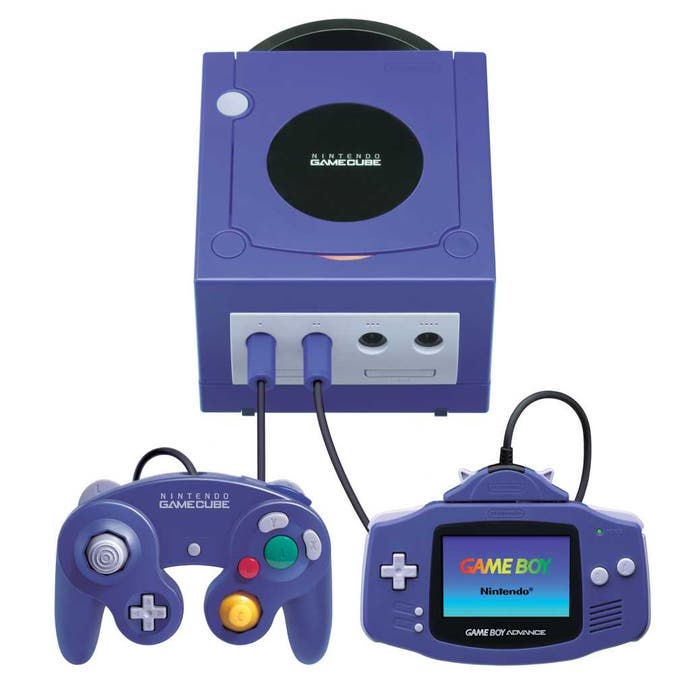
One Week Later
The GameCube is a mighty impressive piece of technology. It really is quite tiny - 14.5cm wide by 15cm long and about 10.5cm deep. The most interesting thing about the Cube's size is actually how much space is left! If you flip the console over you can remove three serial covers for the modem, broadband adapter and (we would guess) an extra memory device. These take up almost 3cm of the console's depth; it could have been even smaller. The Cube also has vents on both sides, so it needs a bit of space to itself, but upon disassembly you can see that it only features one fan, on the left side of the console as you look at it. Unfortunately it's at least as loud as the PlayStation 2, which has met with plenty of criticism on this subject in the past. Despite its modest size the GameCube is fairly heavy, although nothing like as heavy as a PlayStation 2. On the back of the console is the power input, as well as analog and digital A/V outputs. The GameCube can output high definition video for digital output devices and through its analog port just about anything except RGB. This is a point of some frustration for Nintendo shoppers - the GameCube, like the Nintendo 64, does not natively support RGB output and will require some level of modification to do so. RGB separates the video output into three separate colour channels, which is said to help eliminate colour bleeding. It is often considered by gamers to be the single best way to play games, and its absence from the GameCube is annoying. Thankfully then the S-Video output is incredibly good. The image quality is startling - perhaps thanks to the excellent video quality of ATI's 'Flipper' graphics chip at the heart of the console - and the early games (particularly Wave Race) do a good job of demonstrating this. In early testing though it emerged that the Game Cube 'didn't like' one of my televisions. Through whichever method we used, the output was black and white only. In my experience, S-Video is standard independent - I've never had a problem with such a thing as 'PAL S-Video' or 'NTSC S-Video', but even with a television perfectly capable of 50 and 60Hz S-Video on a PAL output, we ended up with black and white. What this proves is that having a television that can handle 60Hz signals isn't going to be enough, you need a television such as my larger Sony model, which can handle pure NTSC signals. It would appear from these experiments that RGB is the only format which is truly signal format independent, and the GameCube doesn't support it. Ho hum. The console's menuing system is simple yet effective. If you load the machine without a disc in or hit buttons during the GameCube boot-up animation, you are whisked away to a translucent cube which you can move from side to side to unveil different options. Go to the right and you can change the date and time; go to the left to access memory card data; go downwards to access 'Options'; and up to access data on the disc in the drive. The options menu itself is somewhat disappointing compared to the PlayStation 2's technical readouts and other functions, lacking much beyond mono / stereo options and screen offset controls.
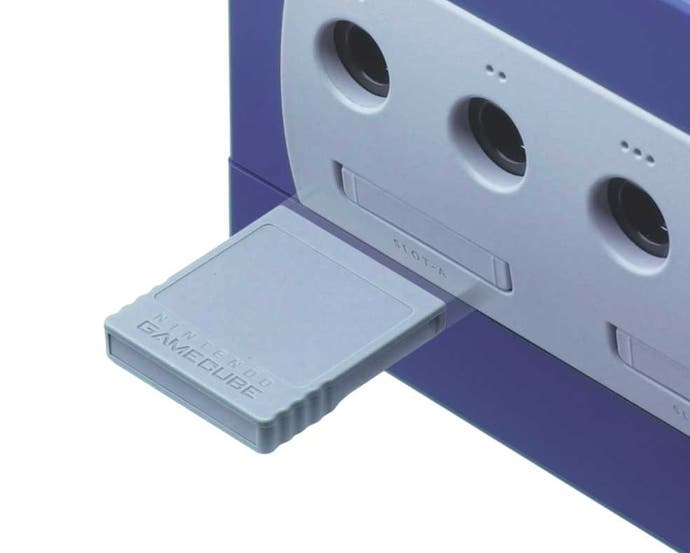
Bits And Bobs
One of the things that strikes you about the media which the GameCube uses is just how small everything is. Not just the discs themselves, which are CD single size (there's no interoperability there, this is a one function device), but the memory cards. I was frankly expecting a PS2 equivalent size - that's what I'm used to - but the GameCube's memory card is only just over half the size, slotting firmly into one of the two points on the front of the console. It's amazing how quickly the machine saves data to the card too. The controller is perhaps my favourite thing about the GameCube though. As just about everybody who has visited my house since last Monday has commented, it's like a perfect blend of the PlayStation 2 and N64 controllers. The only complaint so far has been the placement of the D-Pad. The Game Cube controller is laid out very much like a PlayStation 2 Dual Shock pad, although the handles are curvier, and fit nicely into the palms of your hands, whereas the Dual Shock's frankly do not. The shoulder button triggers don't just click, they can be gently pulled too, allowing for different levels of manipulation - particularly suitable for racing games - and when almost completely depressed a final pull produces a trigger-like click. A third shoulder button which clicks once (and has been used for things like map screen toggles so far) sits just on the near side of the R trigger. The left analog stick is placed high on the controller, where the D-Pad could be found in the Dual Shock, and feels much better for it, while the D-Pad replaces the left analog stick of the Dual Shock design. The right analog stick is as per Dual Shock, but is referred to as the C-Stick, controlling camera functions and the like. And for the first time in a couple of consoles, Nintendo have dispensed with the familiar arrangement of four proportional buttons on the right. The central green button, A, is substantially larger, with a smaller red B button on its left. Curving over the top of A is the Y button, and curving over the right hand side of A is the X button. In the centre of the controller, below the grey GameCube logo, sits the Start button. Using the controller is delightful. Although the D-Pad is a mite awkward you rarely have to use it, and the triggers are responsive and much more resistant than those found on the Dreamcast controllers, for instance. One concern is that the analog sticks are quite small, so using them as analog sticks - choosing to tip-toe, break into a walk or a run etc - is more difficult than on the PlayStation 2. That said, I have found with the PS2 a tendency for my left thumb to slip slightly to the side, forcing me to lose control for an instant as I readjust, often with devastating consequences in that perennial favourite of mine SSX.
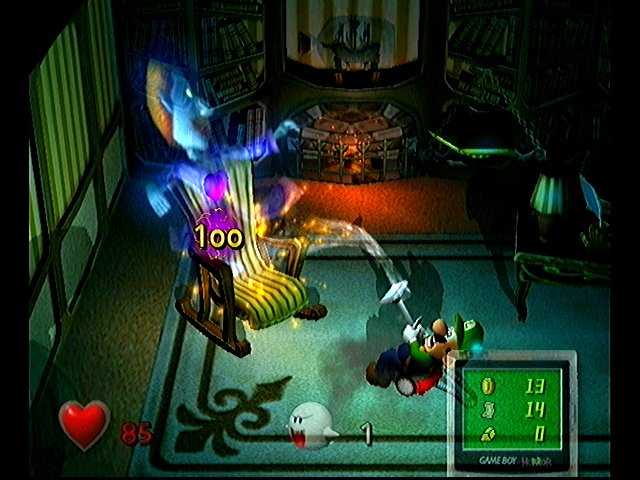
Luigi's Mansion
Let's finally move on to the games. I had an argument with a reader last week about the system's launch titles. He told me in no uncertain terms that none of them was a must-have, whereas I told him most assuredly that they were. I still feel that way. One by one then. I feel Luigi's Mansion is perhaps the least well understood of the lot. A bunch of websites lamented its passing, claiming that it tailed off and got boring, and that there's only so much fun you can have vacuuming up ghosts. Well, to them I say "poppycock". Luigi's Mansion's problems lie in the Japanese text, which needless to say I can't read. Since I can't read it, I can't decipher the clues printed in the top left of the screen, nor the character speeches, which would be useful. That said, the visuals, audio and gameplay are absolutely the best I have come across in the Mario Brothers' various adventures over the years. Every little thing is animated, right down to the trembling of Luigi's hand as he reaches for a doorknob and the quivering of his moustache. Not to mention the Game Boy Horror he clutches in his left hand and the vacuum cleaner on his back, which he swings around in delight when he's victorious. The audio accompaniment is very catchy, although much eerier than anything in previous Mario Brothers adventures. Luigi even hums it in the dark! As far as the gameplay is concerned - wow. I had almost expected it to get slightly dreary, but I've been playing the game for hours at a time, only eventually putting it down for a meal or because I've gotten stuck at an awkward point. The reward structure is the most impressive thing, with coins, gold bars and paper money hidden around the various rooms on the one hand, and harder to find jewels and even bits of missing brother Mario's clothing in certain areas. The further you get into the game, the more interesting your adversaries, and the more involved you have to get in capturing them. I thought the sections I saw at The Nintendo Show were enticing; the areas I've witnessed so far in Luigi's Mansion are breathtaking.
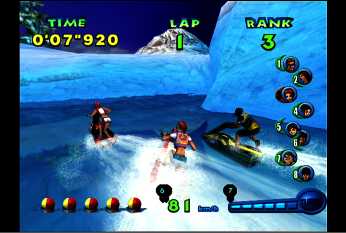
Wave Race : Blue Storm
Visually the most conventional of the three games on display, Wave Race : Blue Storm is a graphical marvel. A landmark. And yet, the water is somehow too active. The rippling and bubbling is definitely exciting, and storm-driven waters lashing against the shore are incredibly realistic, but there's a level of activity in the water that you rarely see in real life, particularly during the inland races. Nevertheless, you would have to be mad not to find things like mountain ranges reflected in the water beautiful. The riders are much better detailed too, and they swing themselves about far more actively than in Wave Race 64. The biggest change visually though from the original Wave Race is the ability to see underwater, right to the bottom of the ocean in certain levels, and the various creatures, rocks and corals that occupy the depths below. Wave Race is teaming with life and interaction. Killer whales leap from the sea and splash down creating soaring waves in the Cool Ocean level, and huge icebergs splash down from above. In the City Harbor level crates splash down from the water and boats ride on the waves at their moorings. The game is extremely active. The weather effects are far and away the best part of Wave Race though. When you head out onto Ethnic Lagoon (don't ask) and it's spitting water at the camera, it actually feels wet. It's a sensation I've never experienced before in a computer game. It plays extremely well too. The control system is easy to get used to and, as we discovered at The Nintendo Show, as long as you have the tenacity and common sense to utilize it under pressure, you can pull through even the trickiest of races. With Trick modes complementing the usual race modes and a gazillion different things to do, I've yet to even try everything, let alone compete with myself for better times. Wave Race strikes me as a solid all-rounder.
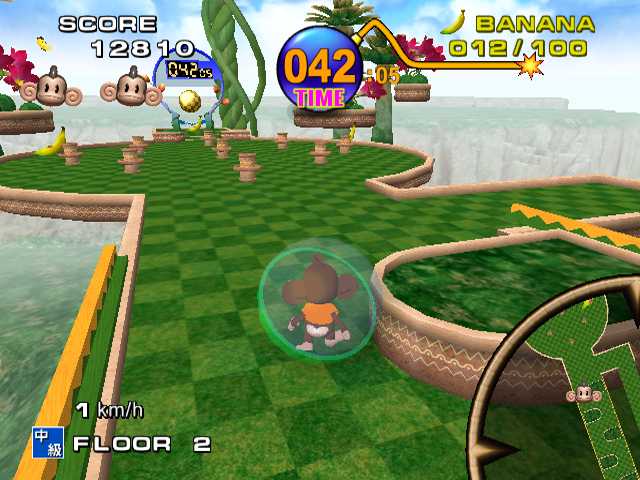
Super Monkey Ball
The real star of the show though is Sega's Super Monkey Ball, a game about a monkey, in a ball. At first when you fire it up it seems quirky but not all that exciting. The most interesting sounding modes - Monkey Billiards, Monkey Bowling and Monkey Golf - are all hidden behind the requirement of several thousand points. The trick is to complete various parts of the single player game, which requires you to navigate your monkey around elaborate courses without falling off or running out of time. This is increasingly difficult as things like pinball bouncers, steep slopes, jumps, speed boosts, moving floors and other obstacles are introduced. And despite the name, like virtually everything else in Super Monkey Ball this can all be played with one, two, three or even four players if you wish By completing levels and setting new high scores you can unlock sections like Monkey Billiards (arguably better than Virtual Pool 3), Monkey Bowling (certainly the best bowling game ever) and Monkey Golf (the most frustrating of the three, but easily the most enticing). These Mini Games are complemented by several further Party Games: Monkey Racing (a two to four player head-to-head around some incredibly tricky courses) and Monkey Fighting (two monkeys, both with boxing gloves on springs, fighting to beat the other off the platform the most times while picking up powerups like Vortexes and Bigger Gloves). Then there is Monkey Target, Sega's version of Pilotwings, which gives the old girl a run for her money. In this mode monkeys race down a slope and propel themselves into the air, then try to hit a target in the sea. Beforehand you have to spin a wheel of misfortune to find out whether clouds, mines, bombs or nothing will impede you. It's manic fun; a darn sight more than Mario Party ever was, and with striking visuals and audio to match. Futhermore, it's the best game about monkeys, ever.
Conclusion
Many have criticized Nintendo's GameCube. Many have drawn attention to its questionable sales figures. Many have said it won't cut it in the long run. Well I've got one lads, and I'm not regretting it so far. The games are of an incredible quality and have that unmistakable Nintendo touch to them. They are the sort of games that will drive gamers to buy the console, and as Nintendo ramp up the release schedule with games like Rogue Leader, Pikmin and Star Fox, there will be even more to say for the GameCube. The Xbox is going to have a lot to do in Japan if it wants to compete on Nintendo's terms, and I think in the long run, so will the PlayStation 2.
-
Star Fox Adventures: Dinosaur Planet preview

